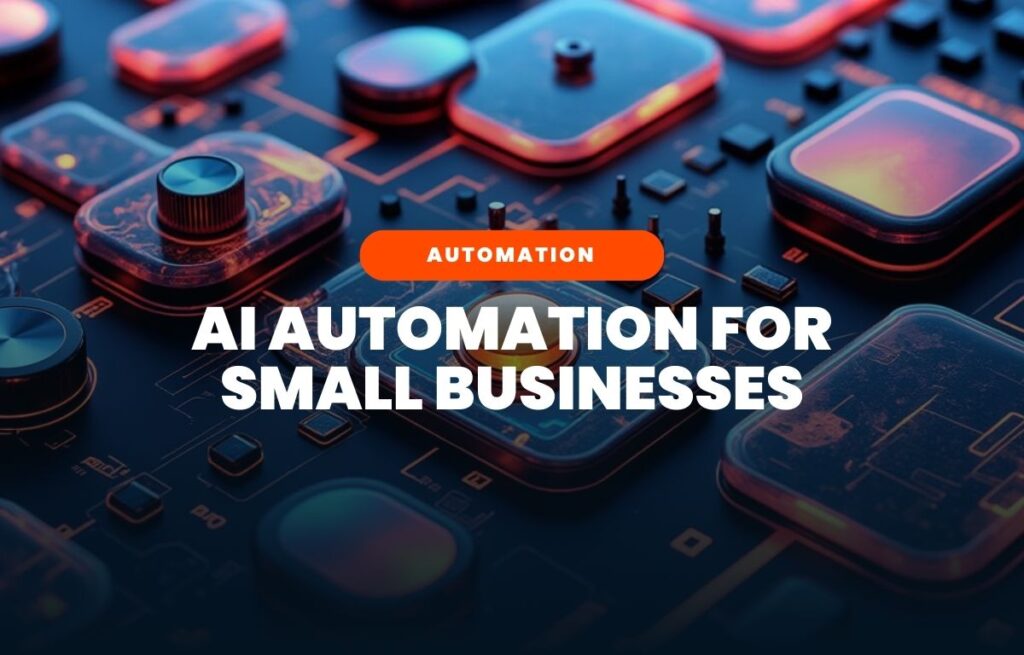Simplify your marketing automation strategy. Use AI to personalize campaigns, optimize workflows, and turn data into actionable insights effortlessly.
Read More »

Small business owners spend nearly 68% of their time on operational tasks like data entry, scheduling, and managing finances. That leaves only 32% of your time left for strategy and growth, which is not going to move the needle like you had hoped.
While these tasks are important and need to be done, they are exactly the kind of tasks you should have AI automate for reliable, repeatable and efficient results, ensuring there's more time for the strategic and creative tasks that allow you to grow your business.
This article explores automation ideas for your small business using AI and how automating these processes can help you reclaim your time to focus on what truly matters.
Traditional automation is like an assembly line—efficient but rigid. It’s great at doing the same task over and over as long as nothing changes. AI, on the other hand, is like hiring an assistant who’s a quick learner and can adapt to new challenges.
When you combine the two, you get AI automation—the power of automation with the flexibility of artificial intelligence. It’s the difference between a robot that just follows orders and one that can think on its feet, improving processes as it goes.

Running a small business is no walk in the park. Some days, it feels like there’s always one more email to send, one more task to cross off, and never enough hours to do it all. The weight of juggling everything—while trying to grow your business—can be exhausting. AI automation offers a way to lighten the load, bringing clarity to the chaos and making space for what truly matters.
Let’s dive into how they can transform the way you work and help your business thrive.
The Challenge: Endless data entry, data movement, email follow-ups, scheduling, and reporting drain your productivity.
The Solution:
Use tools like Zapier or Make to automate repetitive workflows, such as syncing email inquiries with spreadsheets or sending reminders for overdue approvals. For dynamic reporting, Actiondesk connects directly to your data sources, creating live, automated reports that save hours of manual updates. Automating repetitive tasks transforms these into streamlined business processes.
Instructions:
Although a simplistic example, this approach not only saves time but also ensures consistent and accurate results, letting you focus on what truly matters—growing your business.
The Challenge: Slow follow-ups and inconsistent prioritization lead to missed opportunities.
The Solution:
For human-like, automated follow-ups, Reply.io simulates personalized interactions with leads. Alternatively, Drift handles chat conversations and directly routes qualified leads to your sales team. Pair these with Make to sync leads across your CRM and email platforms, ensuring no opportunity slips through the cracks.
Understanding how to automate small business tasks can make lead generation seamless and efficient.
Instructions:
The Challenge: Keeping up with content creation and posting schedules feels impossible.
The Solution:
Use Lately to transform long-form content into shareable posts, or use Planable for seamless AI-powered content scheduling and team collaboration. Tools like SocialBee can automate engagement analysis, helping you double down on high-performing strategies.
AI-driven solutions like these above will help to optimize social media automation for your small business by generating tailored content, streamlining scheduling, and delivering actionable insights from performance data. This allows you to maintain a consistent online presence without dedicating excessive resources.
📢 Just make sure to humanise and edit the ai-generated content to ensure it's consistent with your brand voice, this will ensure it's unique and engaging.
Instructions:
The Challenge: Managing expenses, invoicing, and reconciliation is tedious and error-prone.
The Solution:
Automate expense tracking with Zoho Expense which categorizes expenses in real time. Alternatively, use Fyle for direct integration with your accounting software. For recurring invoices, tools like Wave streamline billing while sending automated reminders to clients.
Instructions:
The Challenge: Inconsistent service and long response times frustrate customers. Not to mention large volumes of basic support requests that inundate your customer service team.
The Solution:
Create AI chatbots like Tidio or Zoho Desk for real-time customer support or opt for Gorgias, which consolidates communications across platforms while automating common queries. The trick is to reduce the load on your support team by letting ai handle those simple, easy to answer support questions.
You're able to train your bots with company practices, historical data and responses from your agents to ensure personalized and accurate responses every time.
Instructions:
AI automation addresses various challenges small businesses face by streamlining processes, improving efficiency, and enabling smarter decision-making.
Below is an overview of how AI transforms key business functions:

The Problem: Generating high-quality leads while ensuring timely follow-ups and nurturing potential customers can be massive time drain, and if it's takes too long it's likely to not be getting the attention it deserves.
How AI Solves It: AI enhances lead generation processes by automating repetitive tasks like outreach, segmentation, and scheduling follow-ups. It employs predictive analytics to prioritize prospects, ensuring efforts target those most likely to convert, thus maximizing resource efficiency.
For example: you could ask ChatGPT to segment your entire list of email leads, with all the provided information you have on them, to create a new highly segmented list according to geography, demographics, work goals etc which you can then tailor your email marketing message around for a better chance of converting them into a customer.

The Problem: Keeping up with content creation, scheduling, and engagement while analyzing performance metrics is time-consuming and resource-intensive.
How AI Solves It: AI automates content generation and optimizes posts for audience preferences. It also tracks and analyzes engagement metrics, delivering actionable insights to refine strategies. These capabilities free businesses to focus on creating a cohesive brand presence without being bogged down by day-to-day tasks.

The Problem: Managing a high volume of inquiries while maintaining consistent and timely responses can strain small business resources.
How AI Solves It: AI-powered chatbots and virtual assistants provide instant, 24/7 responses to common queries. These systems learn from past interactions, becoming increasingly accurate and efficient. By combining AI with human oversight, businesses achieve faster resolutions and improved customer satisfaction.

The Problem: Tasks like tracking expenses, managing invoices, and ensuring compliance with regulations are labor-intensive and prone to errors.
How AI Solves It: AI simplifies financial operations by automating expense categorization, account reconciliation, and report generation. Machine learning models identify anomalies, reducing errors and highlighting opportunities for cost savings, while ensuring compliance.

The Problem: Manual, repetitive processes drain time and create operational bottlenecks, limiting scalability.
How AI Solves It: Workflow automation powered by AI integrates apps and systems seamlessly. AI identifies inefficiencies, automates routine tasks, and provides real-time updates, enabling businesses to streamline operations and scale effectively.
Start by focusing on repetitive and time-consuming tasks that don’t require deep human intervention. Examples include:
Absolutely! A common misconception I've found is that many small business owners thinks it's super-expensive to setup and maintain, and needs a highly-paid specialist to implement it properly. Many AI tools are designed with small businesses in mind, offering free or affordable pricing tiers. These solutions eliminate the need for hefty upfront investments or costly specialists. Plus, they’re often user-friendly, making it easy to implement without extensive technical knowledge.
Not at all. In fact, AI can enhance personalization by analyzing customer data to tailor interactions, and allow you to have a "human in the loop", for example:
No. Many modern AI tools are built to be user-friendly with intuitive drag-and-drop, no-code interfaces. They often provide:
AI can really help you make an impact across various departments, have a look below. But one of the biggest benefits I'd say is that it will allow you to understand your business better because a common by-products of effective automation is providing more reports and analysis of your business processes through automated growth.
It’s a common misconception that AI is very expensive. There are many affordable automation tools that offer scalable pricing plans, starting with free versions for small-scale use. Require minimal hardware or infrastructure upgrades, as many are cloud-based. You can be automating some of your most tedious process within a few days and it'll cost next to nothing.
Start by identifying specific challenges or inefficiencies in your business. What areas are giving you the most "headaches" or issues, or what areas do you feel need more resources allocated to them given their importance. For example: If lead conversion is slow, consider automating your sales pipeline. If customer inquiries are overwhelming, implement a chatbot. By focusing on clear objectives, you can ensure AI directly supports your business growth.
Yes, reputable AI tools prioritize data security with features like encryption, secure integrations, and compliance with regulations such as GDPR or CCPA. Always choose tools with transparent data policies.
Time-saved is going to be a huge benefit but it's not the most important one. The following are some of the key benefits you'll enjoy once you start automating your business processes.
AI automation isn’t just for large enterprises—it’s a powerful tool for small businesses aiming to save time, reduce costs, and operate more efficiently. By addressing challenges in lead generation, customer support, financial operations, and workflow management, AI offers practical solutions tailored to your unique needs.
Take the first step today. Identify one task that's bothering you and hampering progress. This is a prime candidate you can automate, then review some of the relevant tools above to see how it could help you. Once you're setup and starting to automate you'll start to experience how AI can help increase your output, reclaim your time and sharpen your focus on growth and innovation.

With 20+ years in eCommerce and a proven history of scaling a 7-figure business, I know how to transform challenges into opportunities for growth. As the former Head of E-commerce for a European food tech company, I managed 14 e-shops across Europe and South Africa. Now, I specialise in helping professionals like you unlock the potential of AI automation for your business.
Over 1,800 students have already enrolled in my online courses to master these skills. Whether you’re looking for hands-on AI automation services or want to upskill with my courses, I’m here to help. Connect with me on LinkedIn to discuss your needs or join my programs to start building smarter, more scalable systems today!
Simplify your marketing automation strategy. Use AI to personalize campaigns, optimize workflows, and turn data into actionable insights effortlessly.
Discover how AI content automation transforms workflows with tools for automatic content creation, saving time while enhancing creativity, efficiency, and scalability.
Discover how TikTok automation using AI can streamline your content creation process. Learn tools, tips, and strategies to save time, boost engagement, and grow your TikTok presence effortlessly.